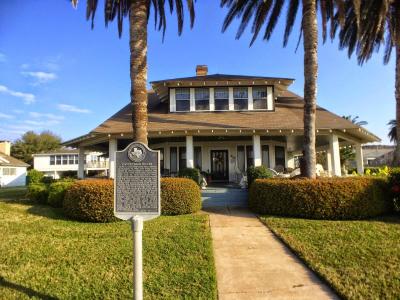The town of Palacios is located along the Tres Palacios Bay, an inland bay of Matagorda Bay, on the central coast of Texas. Houston is approximately 110 miles to the northeast and Corpus Christi is approximately 110 miles to the southwest.
According to legend, a Spanish shipwrecked near Palacios. The sailors saw a mirage of three palaces and swam toward the shore where the palaces seemed to be. The palaces disappeared, but the name, Tres Palacios (“Three Palaces”), did not. Currently, the name is pronounced puh-LASH-us, and historians believe it was named after José Félix Trespalacios, the Mexican governor of Coahuila y Texas.
When Texas became a republic in 1836, Matagorda County was organized. The area was ranch land and continued as such until cotton began to be farmed. The climate, the Gulf of Mexico, navigable streams, the railroad, and land all attracted land developers to South Texas around the turn of the century.
A real estate agent named W. C. Moore and others formed a corporation called The Texas Rice Development Company and developed an area in West Matagorda County,19,400 acres, on Tres Palacios Bay. The area, called Bull Pasture, had been part of the famous Abel H. ‘Shanghai’ Pierce Ranch. A town was laid out at Hamilton Point in 1902 and named Tres Palacios (the Tres was later dropped).
The population grew quickly. In 1904 construction of a “Pleasure Pavilion” was started on the central waterfront. It featured a two story open-air central structure with two large wings on either side, and offered entertainment ranging from dancing and skating to basketball games. Numerous buildings went up around this time. The City of Palacios was incorporated in 1909. Palacios continued to grow throughout the 1910s and 1920s.
Camp Hulen (originally Camp Palacios) was founded in 1925-26 as a summer training camp for the 36th Infantry of the Texas National Guard. It was leased to the U.S. War Department in 1940 and became a training facility for anti-aircraft artillery, housing nearly 15,000 personnel at its peak, as well as a number of German war prisoners. With its large military population, Palacios played host to visiting stars such as Rita Hayworth and Carole Landis.
After World War II, Camp Hulen closed, and the population of Palacios declined. Hurricane Carla hit in 1961, causing severe damage to the town and destroying many historic structures. Since that time, Palacios has begun to grow again, with the formation of a vibrant Vietnamese immigrant community in the 1970s and ’80s, as well as people from all over America discovering the beauty and tranquility of this special place.

Palacios is home to several historic properties that are listed on The National Register of Historic Places and the Texas Historical Commission (THC).
- Price-Farwell House
- R. J. Hill Building
- Camp Hulen

Owned and operated by the Palacios Area Historical Association, the City by the Sea Museum is a resource center for visitors to experience and learn from the region’s diverse cultures and history. The Museum collects, conserves and interprets the material evidence of the prehistory, history and natural history of Palacios, Texas and the surrounding region; including along the shores of and in the adjoining waters, with emphasis on the social and cultural history of this area. This serves to preserve the past, record the present and provide perspective for the future.
The museum has many exhibits on display. General admission is $5 per adult and children are free.
Hours of Operation: Monday Closed. Tuesday-Friday 12:30pm-5:30pm. Saturday 10am-2pm. Closed Sunday.
Museum is located at 401 Commerce Street, Palacios, Texas, 77465.
Have questions? Call (361)972-1148 or museumpalacios [at] gmail.com (email)

La Salle
In 1995, Rene-Robert Cavelier Sieur de la Salle’s ship, La Belle was discovered in the murky waters of Matagorda Bay. It is arguably the most important shipwreck in the Western hemisphere, for three reasons:
1. La Salle’s, a French explorer, mission was to find the Mississippi River and establish a new trade route.
2. The excavation of La Belle in the mid-1990s pushed the limits of archaeological technology, eventually recovering 1.6 million artifacts.
3. La Belle settled into the bottom of Matagorda Bay, preserving many items that normally deteriorate in water such as rope, leather, and even human tissue.
Palacios was the headquarters for the excavation between 1996 and 1997. The City by the Sea Museum is proud to feature some artifacts from this historical event. A 30 ft. replica of the vessel, La Petite Belle, is at South Bay Marina.

In 1975 when Saigon, the Capital of U.S.-backed South Vietnam, fell to Communist North Vietnam many South Vietnamese fled by boat or plane to the United States. The Vietnamese that came to Palacios, Texas worked in the shrimping and crabbing industry. Today the Vietnamese fisherman leads the largest fleet of shrimp boats on the Texas Gulf Coast docked at the picturesque and friendly town.
In 2012 Tuyen Vu, a former shrimper and now store owner, after years of seeing fishermen go out to sea, and some not come back, decided to honor all fishermen, with a 12-ton statue of Jesus Christ. It took six months for the order to be filled and have it shipped whole from Vietnam. The impressive 15-foot statue set atop a 15-foot-high base can be visited on Margerum St. The views from the statue are impressive and well worth a visit, as it overlooks West Matagorda Bay, and the colorful shrimp fishing boats docked in the harbor.
